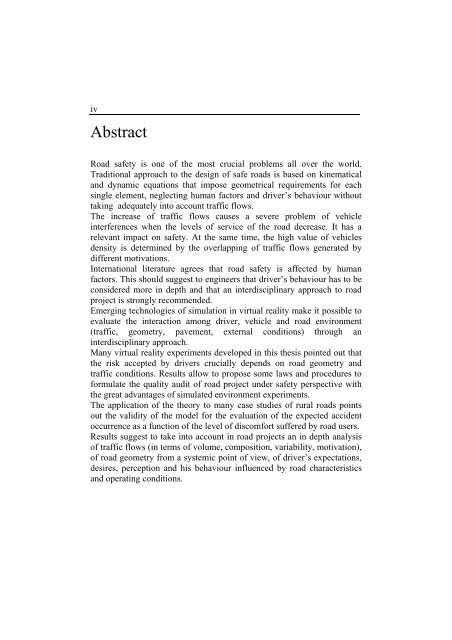Analisi degli effetti indotti dalla funzionalità stradale sulla sicurezza ...
Analisi degli effetti indotti dalla funzionalità stradale sulla sicurezza ...
Analisi degli effetti indotti dalla funzionalità stradale sulla sicurezza ...
Create successful ePaper yourself
Turn your PDF publications into a flip-book with our unique Google optimized e-Paper software.
iv<br />
Abstract<br />
Road safety is one of the most crucial problems all over the world.<br />
Traditional approach to the design of safe roads is based on kinematical<br />
and dynamic equations that impose geometrical requirements for each<br />
single element, neglecting human factors and driver’s behaviour without<br />
taking adequately into account traffic flows.<br />
The increase of traffic flows causes a severe problem of vehicle<br />
interferences when the levels of service of the road decrease. It has a<br />
relevant impact on safety. At the same time, the high value of vehicles<br />
density is determined by the overlapping of traffic flows generated by<br />
different motivations.<br />
International literature agrees that road safety is affected by human<br />
factors. This should suggest to engineers that driver’s behaviour has to be<br />
considered more in depth and that an interdisciplinary approach to road<br />
project is strongly recommended.<br />
Emerging technologies of simulation in virtual reality make it possible to<br />
evaluate the interaction among driver, vehicle and road environment<br />
(traffic, geometry, pavement, external conditions) through an<br />
interdisciplinary approach.<br />
Many virtual reality experiments developed in this thesis pointed out that<br />
the risk accepted by drivers crucially depends on road geometry and<br />
traffic conditions. Results allow to propose some laws and procedures to<br />
formulate the quality audit of road project under safety perspective with<br />
the great advantages of simulated environment experiments.<br />
The application of the theory to many case studies of rural roads points<br />
out the validity of the model for the evaluation of the expected accident<br />
occurrence as a function of the level of discomfort suffered by road users.<br />
Results suggest to take into account in road projects an in depth analysis<br />
of traffic flows (in terms of volume, composition, variability, motivation),<br />
of road geometry from a systemic point of view, of driver’s expectations,<br />
desires, perception and his behaviour influenced by road characteristics<br />
and operating conditions.
















